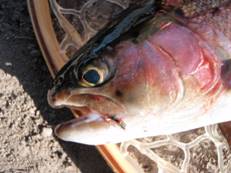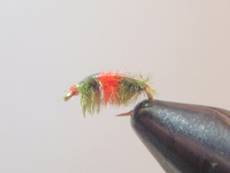ROYAL RAY CHARLES
I have been fishing one of the most heavily fished still waters on the eastern side of Washington State, and I have tied several scud patterns. Each of them has a spot in my still water box but I came up with a simple and most effective pattern ever.
What I learned about scuds is that they develop an "orange-hot-spot" caused by internal parasites. Some might refer as "pregnant spot" but the fact is "dying spot" that makes any still water trout gorge on dying scuds.
| Editor's Note |
|---|
| The orange spot is normally caused by the egg mass. Dead scuds turn orange due to carotene. |
I tied some Ray Charles in plain olive and gray. Then I noticed that I could work on "hot-spots" without breaking its silhouette. I wrapped orange ostrich herls between olives, as tying red floss in Royal Wulff. Thus the name, "Royal Ray Charles", was born.

This has become one and only scud pattern so far. It keeps catching those heavily fished trout. I believe it catches the trout eye as a general olive scud; then the "hot-spot" must trigger some instinctive aggression. Furthermore, there is need for even spacing wraps of thread or wire in this pattern, which makes this pattern simpler and funnier to tie than any other scud patterns. It will works very well in the Paradise Valley spring creeks.

Materials:
- Hook: TMC 2457, Dai-Riki 135, or MFC 7045 size 14, 16, and 18
- Thread: Uni-thread 8/0 red
- Shellback: Large pearl tinsel for #14 & 16, medium for #18
- Body: 2/5 olive, 1/5 orange, and 2/5 olive ostrich herls
Step 1: Wrap the thread toward the bend of the hook then make a layer back to the eye. Tie in pearl tinsel and wrap back toward the bend. Though it may look overdo, this process is very important as it will be a solid base that will make the ostrich body full and fluff.
Step 2: Tie in two olive ostrich herls and make 2/5 of the body. DO NOT cut them for now.
Step3: Tie in two orange ostrich herls and wrap a "hot-spot" exactly in the middle of the fly. Proportion has to be 1/5 of the body.
Step 4: Wrap remained olive ostrich herls to form the front 2/5 and tie off.
Step 5: Wet your fingers little a bit with your saliva and pull back fibers so they don't get wrapped in when forming the head. Finally pull the tinsel forward, tie it off, and whip finish.
How to Fish:
This fly should be fished under an indicator with the right amount of split-shot to cover the depth. When "sight-nymphing" in gin-clear spring creeks indicators may not be needed, instead, like a heron, hone your stalking skills to get as close as you can.For more great info, check out:
Beginning Fly Tying | Intermediate Fly Tying | Advanced Fly Tying.
